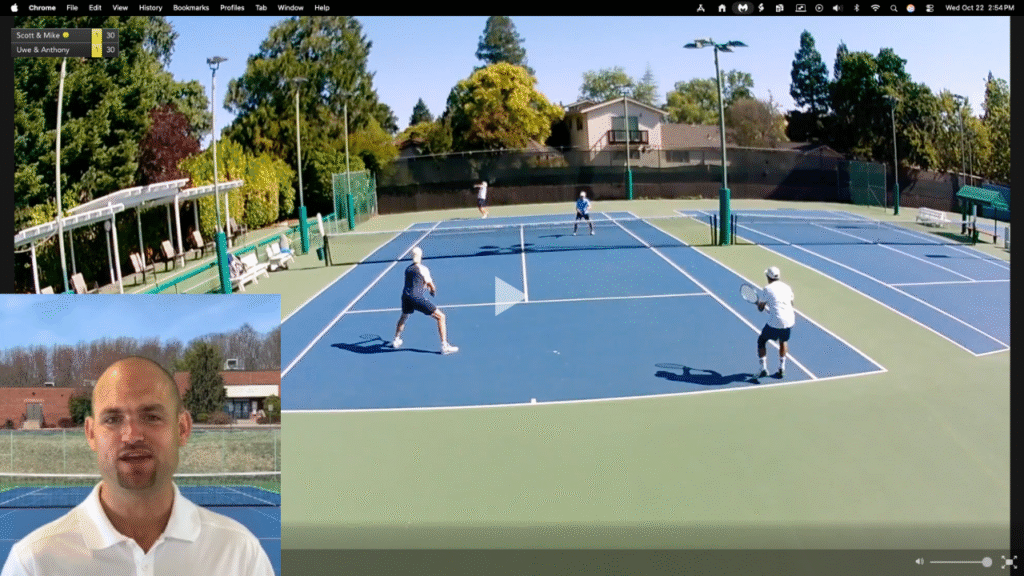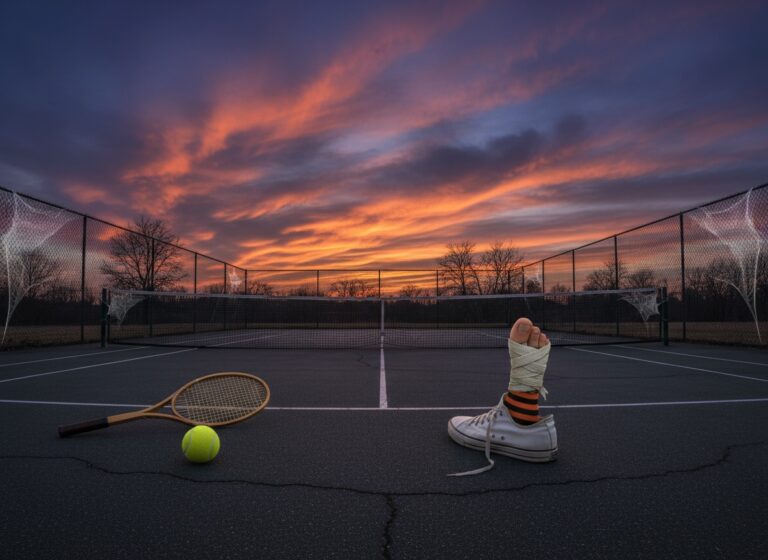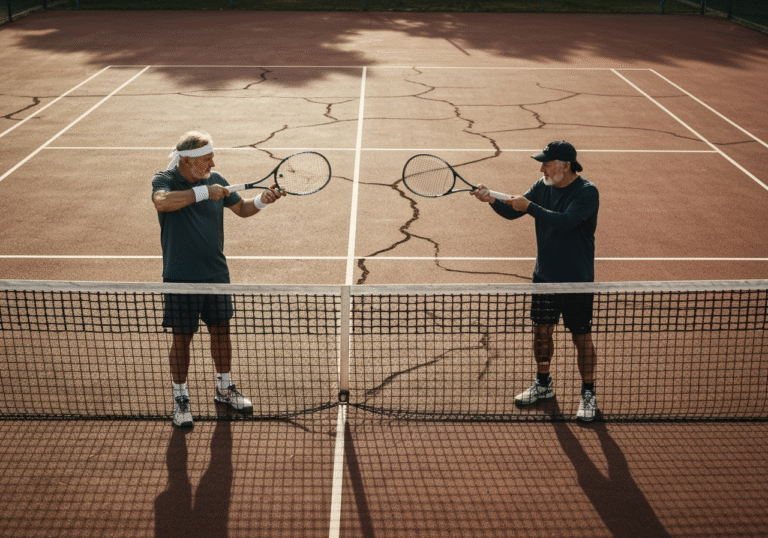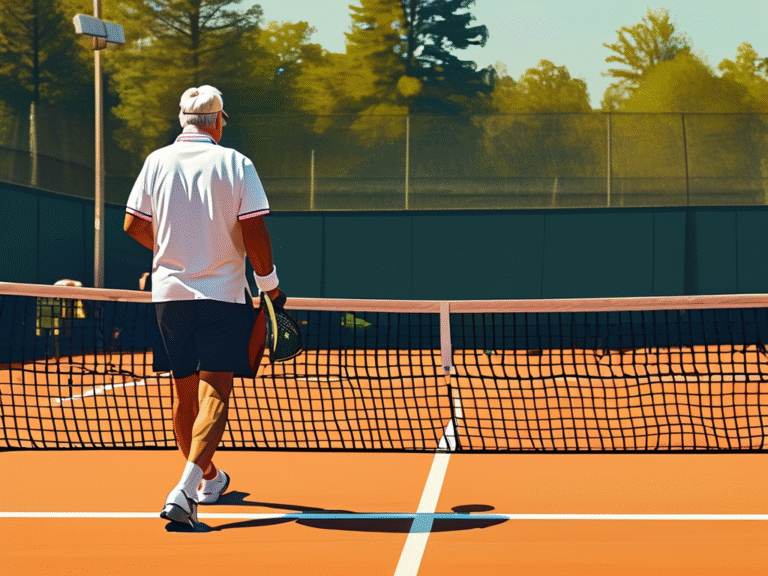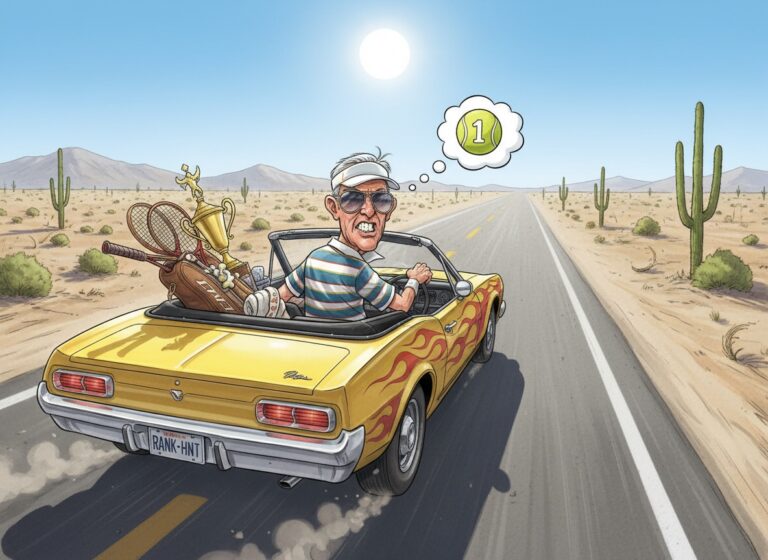It’s always a little nerve-wracking watching your own match on video.
It’s like hearing a recording of your own voice — but worse, because in tennis footage, there’s no reverb to hide behind. Just the sound of sneakers squeaking, grunts that don’t sound nearly as athletic as you thought, and your partner saying, “Yours!” one beat too late.
Recently, I had the privilege (and mild trauma) of reviewing one of my tournament doubles matches with Coach Ryan Reidy, founder of Two Minute Tennis. Ryan is a master at explaining complex strategy in plain English — or in my case, in Senior Californian.
The good news? He said the match was well-played, composed, and tactically solid.
The bad news? He also handed me a full page of “things to fix,” which, in my mind, means I’m now basically a full-time project.
The Match Setup
My partner Scott and I had reached the finals at Nationals earlier this year, so we’ve been feeling pretty good about our game. We both hit solidly, we move well for our age bracket (I stress that), and we rarely throw racquets. That’s progress.
This particular match featured — as every senior doubles match seems to — the tall guy. You know the one. The human Redwood planted at the net who makes you feel like you’re rallying into a volleyball blocker.
As Ryan kindly pointed out, “He’s not actually that close to the net — you just never pushed him back.” Which leads to my first humbling revelation.
1. Put the Racket Up — Even When You’re Faking It
Ryan showed me a clip where I move to poach but don’t raise my racket.
“Even if you can’t reach it,” he said, “stick that thing up. The tall guy will see it and instinctively back off.”
Apparently, this “racket-up bluff” is straight out of the Venus and Serena playbook. Venus raises her racket, doesn’t hit the ball, and the opponent still retreats — buying Serena all the space in the world for her cross-court hammer.
Meanwhile, I was out here moving my body but not my racket, which Ryan described as “going for the ball with your legs, not your brain.” He’s not wrong.
So, lesson one: next time you see me lunging at the net with my racket up like a scarecrow, just know — I’m not necessarily hitting it, but I am living rent-free in my opponent’s head.
2. The Magnet Drill — Because Apparently, I’ve Been a Sitting Duck
When your partner gets lobbed, you move back diagonally. When the ball passes you, you retreat to the service line “like a magnet,” Ryan said.
Simple enough. Except, apparently, I don’t do that.
In my match, Scott gets lobbed and I stay glued to the net — heroically positioned for a future head injury. Ryan paused the video and said, “See? Now Scott has to hit an impossible shot just to keep your face intact.”
He’s right.
The idea is that both net players move in a triangle pattern — forward, back, forward again — always adjusting together like a dance. Except my version of the dance looked more like a dad trying to remember the Macarena.
So that’s next on the practice list: less statue, more magnet.
3. Defensive Lobs: Height Is Your Best Friend
I’ve always prided myself on my lobs. They’re deep, high, and occasionally land on the court I’m aiming for. But Ryan dropped a stat that blew my mind:
A perfect defensive lob should stay in the air for 2.5 seconds or longer.
That’s a skyscraper of a shot. According to Ryan, even pros struggle to handle a lob that hangs that long — it drops vertically, messes with timing, and turns would-be overhead winners into awkward push shots.
In my match, I hit what I thought was a “great” lob, only for Ryan to pause the footage and go, “See this? That’s an offensive lob. And it’s 20 feet long.”
Oops.
Moral of the story: stop aiming for depth; start aiming for time.
Gravity will take care of the rest.
4. Inside vs. Outside Groundstrokes — The Doubles Blind Spot
This was one of those concepts that made me feel both enlightened and mildly embarrassed.
Ryan explained that in doubles, when your opponent hits an outside groundstroke (forehand on deuce side, backhand on ad side), they’re statistically more likely to go cross-court. When they hit an inside groundstroke (forehand on ad, backhand on deuce), they’re more likely to go down the line.
So, if you want to be right more than 80% of the time — “unlike your marriage,” Ryan joked — you adjust based on that.
I realized I’ve been treating every ball the same. No wonder I’m late to half of them.
Now, when the ball’s on the outside, I’ll be pinching toward the middle. When it’s inside, I’ll hold position. Translation: fewer guesses, more logic.
And maybe, just maybe, fewer balls whizzing past my ear.
5. Split-Step Timing — Don’t Jump Like Sabalenka
If you ever want to feel better about your footwork, it turns out I share something in common with world number one Aryna Sabalenka — we both mistime our split step. She jumps too soon and lands before the ball is struck… and apparently, so do I (just more often).
When Ryan slowed down the footage, it was painfully obvious. The opponent struck the ball, and there I was — flat-footed, already descending after contact.
“You want to be in the air as they hit,” Ryan explained. “Not before. Not after.”
He then compared the timing to Coco Gauff’s — who jumps perfectly in sync with her opponent’s contact. “When you’re in the air, your brain’s primed for the reaction. When you’re grounded early, your brain’s waiting on your body.”
So now I have a new mantra:
When they jump, I jump.
It sounds like a bad pop song, but it works.
6. Communication and the Planned Poach
One of my favorite moments in the review came when Ryan froze the screen during one of my poaches and said, “Now this — this is good.”
I had told Scott in advance that I was going for it. He served to the opponent’s outside groundstroke, I cut across, and we won the point.
But the part that stuck with me was the nuance: Ryan said, “Don’t serve too wide. Serve to the outside groundstroke, not off the court.” Why? Because when you pull the returner too far wide, the angle behind you gets bigger — and you end up chasing ghosts down the alley.
So, from now on, when I tell my partner to serve “wide,” I’ll add the fine print: “Go wide — but not off the court.” In other words, stretch them enough to open up space for me to poach, but not so wide that we’re the ones doing the chasing.
7. Serve From the Edge — Scare Them a Little
One subtle but brilliant piece of advice: occasionally stand at the edge of the sideline to serve. You’re not allowed outside the court, but right up against the line is legal — and the angle it creates is wicked.
Ryan said, “Don’t assume your opponent is Roger Federer until he proves it.”
At our level, most returners won’t adjust quickly enough. So, every few games, I’ll sneak over there and see if I can make them feel like they’re returning from the wrong county.
8. When Your Partner Has a Setup Ball — Move!
At one point in the video, Scott gets a high, attackable ball and is going to nail the opponent and I just… watched.
Ryan stopped the video: “See this? When your partner gets a setup ball, you should already be moving in. Anticipate the weak reply, be ready to clean up the crumbs.”
He compared it to basketball players crashing the boards when a teammate shoots — even if the shot goes in, they’re prepared for the rebound.
So next time Scott cracks one, I’ll be there early, ready to pounce — or at least to look like I meant to.
Final Thoughts: The Beautiful Grind of Getting Better
Watching that match with Ryan was equal parts humbling and energizing.
It reminded me that even after decades of playing — and now coaching — there’s always another layer to peel back.
He said something that stuck:
“Coaching others will make you a sharper player — because you’ll start catching your own mistakes faster.”
And he’s right. The more I teach, the more I see my own game clearly.
Maybe that’s the real win here: realizing that learning and competing aren’t separate things. They’re part of the same long, sometimes hilarious, sometimes humbling journey we’re all on.
Now if you’ll excuse me, I have to go practice raising my racket at imaginary opponents and timing my split step to invisible serves.
Join the Conversation
Have you ever had your own “match-video wake-up call”?
Share your story in our Facebook group, Senior Tennis Unpacked Nation — where we trade tips, war stories, and post-match therapy.
And if you haven’t subscribed yet, join Senior Tennis Unpacked for free. You’ll get weekly stories like this plus three bonus guides: Up Your Tennis Game, Frustrated to Focus, and Get Fit, Get Strong.
Because whether you’re chasing ranking points, fixing footwork, or just trying to avoid the next lob over your head — we’re all figuring this out, one rally (and one laugh) at a time.


